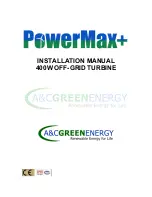
Rutland FM1803-2
Installation & Operation
Document No: SM-146 Issue D 14.03.08
Marlec Engineering Co Ltd
24
TROUBLESHOOTING
In the unlikely event that your Rutland 1803-2 should develop a defect, the
turbine should either be lowered to the ground or secured to prevent the blades
from turning before the following inspection is carried out.
1.
Read the ‘Electrical Connection’ and ‘Up and Running’ sections and be
satisfied that your system complies.
2.
If your Rutland 1803-2 fails to turn, turns slowly or produces low output,
check the following:
Is there sufficient wind?
The Rutland 1803-2 needs 3m/s wind speed to
start charging. The wind speed across the turbine blades may be greatly
reduced in a built-up area compared with weather reports.
Is the On/Off switch in the ‘ON’ position?
Is the battery fully charged?
Check the control unit LEDs, when the red
LED is lit it indicates that the battery is fully charged & the wind generator
will be in “stall” mode.
Is a battery connected to the control unit?
Check the control unit LEDs, if
no LED is lit this indicates no battery connection to the control unit & wind
generator will be in “stall” mode.
Is the battery in good condition?
Check the voltage and electrolyte level of
each battery.
Check electrical continuity
throughout the system, especially look for
corrosion and poor connections in cable joints and connector blocks.
Check the brushes and slipring for wear or damage.
To inspect the
brushes, remove the nacelle by removing the three fixing screws and slide
nacelle backwards towards the tail fin. The brushes and slipring can be
inspected. Remove any black deposits from slipring with emery paper.
Check hub for free rotation with generator disconnected from control
unit.
If the hub does not rotate freely, check for a possible short circuit in the
wiring. If no wiring fault is found refer to your dealer or manufacturer.
If in doubt, refer to your dealer or manufacturer.



















